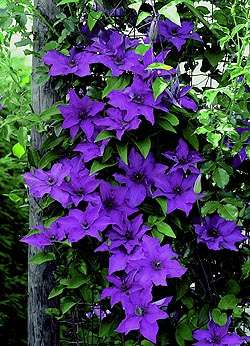Requirements & training
 Large-flowered Clematis thrive best in fertile organic soil, rich in humus, calcium (pH 6 to 7) and kept moist but not wet. If your soil is not fertile enough add compost, rotted manure or a good media. Clematises like their roots shaded and the top growth exposed to the sun.
Large-flowered Clematis thrive best in fertile organic soil, rich in humus, calcium (pH 6 to 7) and kept moist but not wet. If your soil is not fertile enough add compost, rotted manure or a good media. Clematises like their roots shaded and the top growth exposed to the sun.
Varieties with solid colour flowers that like full sun include dark blue, violet and red types (e.g. 'The President', 'Kacper', 'Lady Betty Balfour', 'Ernest Markham', 'Gipsy Queen').
 Clematis 'The President' |
Such a position is required by most of the double-flowered cultivars like 'Duchess of Edinburgh', 'Kiri Te Kanawa', 'Matka Siedliska', 'Sylvia Denny', 'Veronica's Choice', and 'Vyvyan Pennell'. Many clematis can grow well and bloom in semi-shaded places or against a wall facing north (e.g. pastel colored Clematis such as 'Comtesse de Bouchaud', 'Błękitny Anioł' and some small-flowered species - Clematis alpina and Clematis macropetala). Diffuse light or northern aspect encourage more abundant flowering and better flower color of light-colored or shaded varieties e.g.: 'Moonlight', 'Hagley Hybrid', 'Kakio', 'Nelly Moser', 'Dr Ruppel' czy 'Asao'. Most of the clematis are very sensitive to droughts and little humidity. They languish in windy sites.
Training
- over fences and walls
Traning clematis to grow up various kinds of fences or walls is very popular. - over garden supports
Clematis can be grown over various kinds of garden architecture such as arbors, arches or trellises, pergolas, or simply over rods and poles. - over natural supports
Clematis feel at home when growing over perennials, or scrambling through trees, bushes or dwarf shrubs.













